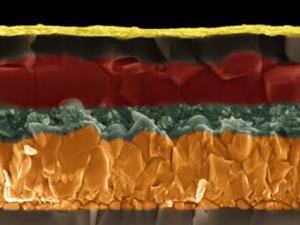Device combines silicon and perovskite technologies and exceeds previous tandem cell performances
The efficiency and stability of an emerging solar cell technology has been boosted by combining perovskite-based cells with traditional silicon cells to form a ‘tandem cell’ that generates more power than silicon cells alone.1
![]()
First reported in 2010, perovskite solar cells have seen significant improvements in efficiencies, rising from under 4% in the early days to 22% in 2016. However, a long-standing limitation is their poor stability when exposed to heat, moisture and air. Nevertheless, researchers believe that using perovskites in tandem with more traditional solar cells including silicon shows the greatest potential for reaching industry targets of 30% efficiency and beyond.
In 2015, efficiencies for perovskite–silicon tandem cells reached 21.2% for a small cell only 0.17cm2 in size developed by Swiss researchers.2 Now, Michael McGehee at Stanford University and Zachary Holman at Arizona State University and colleagues have achieved 23.6% efficiency on a 1cm2 cell with increased stability in hot and humid environments.
‘Silicon solar cells are responsible for a $30 billion (£24 billion) per year industry. We have taken a 21% efficient silicon cell and upgraded its performance by more than 10%,’ says McGehee. ‘There are still improvements we can make to most of the layers in the solar cell. We think we will be able to achieve 30% power conversion efficiency, which is extremely exciting.’
The team used a new, more stable perovskite semiconductor containing caesium that provided greater flexibility for depositing the perovskite cell on top of the silicon cell, while improving optical and electrical performance. The addition, via atomic layer deposition, of an indium tin oxide (ITO) layer helped protect the perovskite layer from the damaging effects of the sputtering process used to put down the top transparent electrode.
![]()
Since the upper perovskite cell absorbs the visible part of the spectrum where the photons have more energy, this generates a higher voltage than the silicon solar cell. Meanwhile, the bottom silicon cell was optimised to absorb the infrared photons that the perovskite cell cannot absorb, resulting in higher power conversion efficiency.
The combination of the more stable perovskite and the protection provided by the ITO layer allowed the cells to operate for more than 1000 hours in air and 40% humidity without significant degradation. The encapsulated cells also passed the standard damp heat testing protocol involving storage at 85ºC and 85% relative humidity for 1000 hours.
‘This work is a significant step forward in the development of perovskite–silicon tandem cells, both in terms of absolute efficiency, as well as stability,’ says Tom White who works on solar cells at the Australian National University, Canberra. ‘The long term reliability of perovskites still needs to be proven before they become a commercial reality, but this work moves the field forward, and the tandem approach provides a clear pathway to achieving efficiencies beyond what is possible with silicon alone.’
References
1 K Bush et al, Nat. Energy, 2017, 2, 17009 (DOI: 10.1038/nenergy.2017.9)
2 J Werner et al, J. Phys. Chem. Lett., 2016, 7, 161 (DOI: 10.1021/acs.jpclett.5b02686)












No comments yet